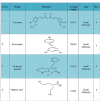Current promising treatment strategy for glioblastoma multiform: A review
- PMID: 31410248
- PMCID: PMC6661528
- DOI: 10.4081/oncol.2019.417
Current promising treatment strategy for glioblastoma multiform: A review
Abstract
Glioblastoma multiform (GBM) is a heterogeneous group of primary neoplasm resistant to conventional therapies. Due to their infiltrative nature it not fully isolated by aggressive surgery, radiation and chemotherapy showing poor prognosis in glioma patients. Unfortunately, diagnosed patients die within 1.5-2 year treatment schedule. Currently temozolomide (TMZ) is the first choice for the prognosis of GBM patients. TMZ metabolites methyl triazen imidazol carboxamide form complex with alkyl guanine alkyl transferase (O6 MGMT- DNA repair protein) induced DNA damage following resistance properties of TMZ and inhibit the overall survival of the patients. Last few decades different TMZ conjugated strategy is developed to overcome the resistance and enhance the chemotherapy efficacy. The main aim of this review is to introduce the new promising pharmaceutical candidates that significantly influence the therapeutic response of the TMZ in context of targeted therapy of glioblastoma patients. It is hoped that this proposed strategy are highly effective to overcome the current resistance limitations of TMZ in GBM patients and enhance the survival rate of the patients.
Keywords: Glioblastoma; resistance; targeted therapy; temozolomide.
Conflict of interest statement
Conflicts of interest: the authors declare no potential conflicts of interest.
Figures




References
-
- Simpson L, Galanis E. Recurrent glioblastoma multiforme : advances in treatment and promising drug candidates. Expert Rev Anticancer Ther 2006;6:1593-607. - PubMed
-
- Reardon D, Wen P. Therapeutic advances in the treatment of glioblastoma: rationale and potential role of targeted agents. Oncologist 2006;11:152-64. - PubMed
-
- Filho AZ. Autophagy inhibition improves the efficacy of curcumin/ temozolomide combination therapy in glioblastomas. Cancer Lett 2015;358:220-31. - PubMed
LinkOut - more resources
Full Text Sources
Research Materials

